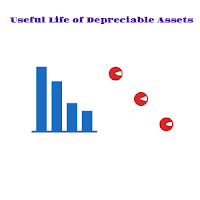Useful Life of Depreciable Assets
 Useful Life of Depreciable Assets is the estimated life set by the business’s management during which it is expected that the Fixed Assets / Non Current Assets will remain useful for the business and after the expiration of such time period, it will be sold out or exchanged with similar kinds
of Assets. Once Useful Life is set, it can be revalued, if required. When the Useful Life of Depreciable Assets is revised, then it is applied from the Period it is made and for future remaining periods.
Useful Life of Depreciable Assets is the estimated life set by the business’s management during which it is expected that the Fixed Assets / Non Current Assets will remain useful for the business and after the expiration of such time period, it will be sold out or exchanged with similar kinds
of Assets. Once Useful Life is set, it can be revalued, if required. When the Useful Life of Depreciable Assets is revised, then it is applied from the Period it is made and for future remaining periods.For Example, if the Cost of Equipment is Rs. 51000, having Useful Life is 5 Years and Residual Value is Rs. 2000. After 2 years, the management of the company revised the policy and estimated that the Assets will be Useful for business for 7 Years, then, so now remaining Useful is 5 Years instead of 3 Years. Now, Depreciation Expense is calculated on revised Useful Life that is calculated as shown below:
Useful Life = 7 Years
Depreciable Amount = Cost - Residual Value - Book Value of Equipment after 2 Years
= 51000 - 1000 - (51000 - 20000)
= 50000 - 31000
= Rs. 29000
Depreciation Expense For The Year = 29000 / 5 = Rs. 5800
Building has more useful Life than Plant & Machinery, Equipment and other Depreciable Assets.
So, Useful Life of Depreciable Assets is important in the valuation of Fixed Assets in order to measure the effectiveness of Assets for the business.
Comments